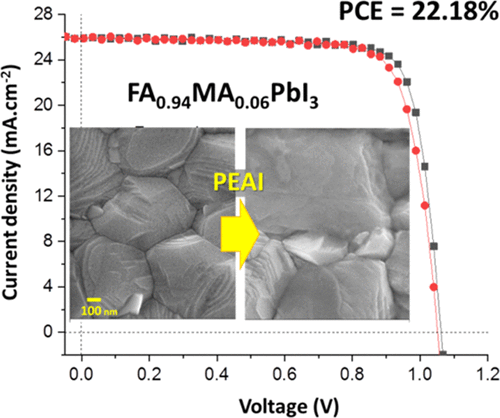当前位置:
X-MOL 学术
›
ACS Appl. Mater. Interfaces
›
论文详情
Our official English website, www.x-mol.net, welcomes your
feedback! (Note: you will need to create a separate account there.)
PEAI-Based Interfacial Layer for High-Efficiency and Stable Solar Cells Based on a MACl-Mediated Grown FA0.94MA0.06PbI3 Perovskite.
ACS Applied Materials & Interfaces ( IF 8.3 ) Pub Date : 2020-08-05 , DOI: 10.1021/acsami.0c09970
Tao Zhu 1 , Daming Zheng 1 , Jiawen Liu 2 , Laurent Coolen 2 , Thierry Pauporté 1
ACS Applied Materials & Interfaces ( IF 8.3 ) Pub Date : 2020-08-05 , DOI: 10.1021/acsami.0c09970
Tao Zhu 1 , Daming Zheng 1 , Jiawen Liu 2 , Laurent Coolen 2 , Thierry Pauporté 1
Affiliation

|
Among the three-dimensional (3D) organic–inorganic hybrid perovskites (OIHPs), mixed formamidinium and methylammonium cation lead iodide is one of the most promising for solar cell application. After optimizing the use of a methylammonium chloride (MACl) additive for the preparation of compact, high-quality, and large crystal grain layers made of a pure α-phase perovskite with the FA0.94MA0.06PbI3 composition, the treatment of the perovskite surface by a 2-phenylethylammonium iodide (PEAI) solution has been performed. This treatment, without any thermal annealing, leads notably to the spontaneous formation of a crystallized (PEA)2PbI4 two-dimensional (2D) perovskite nanolayer at the film surface due to partial organic cation dissolution. This buffer layer is shown to favor a fast transfer of the holes toward the hole transporting layer (HTL) and to reduce the recombinations at and near the perovskite/HTL interface in perovskite solar cells (PSCs). It is shown to boost their maximum power conversion efficiency (PCE) from 20.37 to 22.18%, while the hysteresis becomes negligible. A comprehensive study of the electrical response of the device has been performed. The electrical impedance spectroscopy (EIS) measurements have been fitted with ad hoc equivalent electrical circuits. The electrical responses due to interface stabilization, the intrinsic dielectric relaxation of the perovskite, and the charge depletion and charge recombinations have been distinguished. The low-frequency capacitance is analyzed as a charge recombination capacitance. The perovskite surface buffer layer is notably shown to suppress charge recombinations from the boosting of the high- and low-frequency recombination resistances as well as from the marked decrease of the low-frequency recombination capacitance. The prepared devices are proven to be especially resistant to electrical stresses, light irradiation, and moisture.
中文翻译:

基于MAC1介导的生长的FA0.94MA0.06PbI3钙钛矿的基于PEAI的高效稳定太阳能电池界面层。
在三维(3D)有机-无机杂化钙钛矿(OIHPs)中,混合的甲din和甲基铵阳离子碘化铅是最有前途的太阳能电池应用之一。优化使用甲基氯化铵(MACl)添加剂制备由FA 0.94 MA 0.06 PbI 3组成的纯α-相钙钛矿制成的致密,高质量和大晶粒层后,对钙钛矿进行处理用2-苯基乙基碘化铵(PEAI)溶液进行表面处理。在没有任何热退火的情况下,这种处理明显导致自发形成结晶(PEA)2 PbI 4由于部分有机阳离子溶解,膜表面的二维(2D)钙钛矿纳米层。示出该缓冲层有利于空穴向空穴传输层(HTL)的快速转移,并减少钙钛矿太阳能电池(PSC)中钙钛矿/ HTL界面处及其附近的复合。它的最大功率转换效率(PCE)从20.37%提高到22.18%,而磁滞则可以忽略不计。已对设备的电响应进行了全面研究。电阻抗谱(EIS)测量已被装上特设等效电路。由于界面稳定,钙钛矿固有的介电弛豫以及电荷耗竭和电荷复合而引起的电响应已经被区分出来。将低频电容分析为电荷复合电容。钙钛矿表面缓冲层特别显示出抑制了由于高频和低频复合电阻的升高以及低频复合电容的显着降低而引起的电荷复合。事实证明,准备好的设备特别耐电应力,光辐射和湿气。
更新日期:2020-08-19
中文翻译:

基于MAC1介导的生长的FA0.94MA0.06PbI3钙钛矿的基于PEAI的高效稳定太阳能电池界面层。
在三维(3D)有机-无机杂化钙钛矿(OIHPs)中,混合的甲din和甲基铵阳离子碘化铅是最有前途的太阳能电池应用之一。优化使用甲基氯化铵(MACl)添加剂制备由FA 0.94 MA 0.06 PbI 3组成的纯α-相钙钛矿制成的致密,高质量和大晶粒层后,对钙钛矿进行处理用2-苯基乙基碘化铵(PEAI)溶液进行表面处理。在没有任何热退火的情况下,这种处理明显导致自发形成结晶(PEA)2 PbI 4由于部分有机阳离子溶解,膜表面的二维(2D)钙钛矿纳米层。示出该缓冲层有利于空穴向空穴传输层(HTL)的快速转移,并减少钙钛矿太阳能电池(PSC)中钙钛矿/ HTL界面处及其附近的复合。它的最大功率转换效率(PCE)从20.37%提高到22.18%,而磁滞则可以忽略不计。已对设备的电响应进行了全面研究。电阻抗谱(EIS)测量已被装上特设等效电路。由于界面稳定,钙钛矿固有的介电弛豫以及电荷耗竭和电荷复合而引起的电响应已经被区分出来。将低频电容分析为电荷复合电容。钙钛矿表面缓冲层特别显示出抑制了由于高频和低频复合电阻的升高以及低频复合电容的显着降低而引起的电荷复合。事实证明,准备好的设备特别耐电应力,光辐射和湿气。































 京公网安备 11010802027423号
京公网安备 11010802027423号